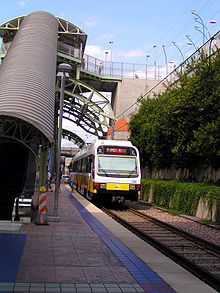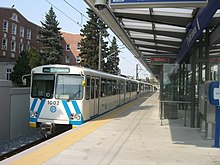Detroit's new light rail system is progressing well, in spite of media reports to the contrary.
Why is this important?
Well, nobody needs to be told about Detroit's economic woes. Looking at other cities like Charlotte, Denver, Salt Lake City, Minneapolis, Dallas, and many others, we see economic investment ballooning as soon as light rail is put in. In many cases, the investment starts well before the trains start running, and light rail usually brings between six and eight dollars of private investment for every dollar spent on building and running the system. Light rail, in other words, acts as a big magnet for investment. Detroit sure could use a magnet for investment...
But looking at cities that recently built light rail, we see the same scenario re-enacted every time. When the first light rail line is proposed, many people don't believe the "magnet" will work in their city, or doubt the figures cited for other cities. Quite a few believe that unlike other cities, residents of their city will never give up their cars, and the trains will run nearly empty, so the whole effort is a boondoggle. Then finally the first line is built. Almost always, the number of riders using it exceeds predictions made by the planners (because Federal planning formulas are extremely conservative). Construction cranes sprout up along the route. Skeptics eyeing the line gradually find their mouths hanging open in astonishment as the predictions come true. Between one and two years after the first line is built, every suburban mayor in the region is making angry speeches about how unfair it is that their jurisdiction has been denied the benefits of light rail. The race is on to see who can get light rail built in their community first. Believe it or not, this really happens time after time, in city after city.
So at this stage, it's not surprising to see the opposition online in comments. What does surprise me is to see articles like the one that came out yesterday morning in Crain's Detroit Business. That's a very reputable, well-respected publication. The article, titled "Woodward Rail: The Great Train Jobbery", focused on supposed attitudes and interactions between officials and engineers, rather than on the light rail plans themselves. The author, Bill Shea, seems a lot better at stirring up controversy and (presumably) grabbing readership for his articles.
I was at the TRU meeting yesterday evening (Monday, July 11) where Megan Owens and representatives of DDOT and the engineering firm URS presented a progress report. I'd like to pass along a few facts to counterbalance some of the claims made in Mr. Shea's article...
Claim:
The proposed Woodward Avenue light rail project is in jeopardy.
The private consortium of investors that has pledged $100 million toward the project's $528 million cost doesn't have faith in the Detroit Department of Transportation's plan and won't provide funding until it does, sources familiar with the situation told Crain's.
Fact: "Rip" Rapson, CEO of the Kresge Foundation, which pledged $35 million, was the most vocal critic of having the light rail tracks run in the center of Woodward Avenue, rather than at curbside. But he made a statement broadcast on Michigan Radio Monday saying he and the Kresge Foundation have never threatened to withdraw their funding.
We are completely committed to making this work. We’re all now negotiating through the details of how to get it done. Not whether it should be done, not whether it can be done, but how it will get done.
Claim:
The engineers for the project insist their design is superior to all other options for Woodward. It's natural that those in the pay of DDOT are going to argue that their plan is the One True Religion, and that anything else is so fatally stupid as to be beneath both contempt and worthiness of discussion.
Fact: The federal grants process requires multiple plans to be considered and carefully evaluated.
DTOGS identified a wide range of potential transit improvements in a study area encompassing the City of Detroit and the Cities of Dearborn, Hamtramck, and Highland Park. Fourteen transit corridors identified in the SEMCOG Regional Transportation Plan (Figure 2-1), including adjacent primary roadways within a two-mile buffer area, and 13 transit technologies were initially identified for evaluation.
DTOGS used a systematic process to narrow the number of alternatives, ultimately resulting in selection of the Project: LRT [Light Rail Transit] on Woodward Avenue between Downtown Detroit and the Michigan State Fairgrounds near 8 Mile Road. (FEIS, sec. ES.5)
After analyzing the fourteen corridors, three were arrived at as most likely: Gatiot, Michigan, and Woodward. Three transit technologies were winnowed out: conventional bus, bus rapid transit (BRT), and light rail. You can see a detailed discussion of each alternative in Section 2 of the Final Environmental Impact Statement (FEIS), linked at the end of this post. (For federally-funded projects like this, the FEIS is like a contract. Once it is approved by both local and federal parties, it's "the law" on how the project will be done. It's not a detailed engineering plan, so issues that couldn't be resolved without careful engineering are left open.)
DDOT representatives and the engineers from URS held several public meetings to get input beginning in July, 2010, and several designs were offered to everybody for consideration; a total of 497 people attended. (Section ES.10 of the FEIS lists the meetings and their attendance.) In the ~500 public comments they received, 91% favored center-running; only 9% thought running along the curbside was better.
There are 517 questions and comments received from the public and from other agencies. Every one of them is listed with a response in Appendix H (linked at the end).
Claim:
The argument amounts to, "We're engineers, we know best. You're not an engineer, so just shut up and hand over the money."
Fact: Matthew Cullen, President CEO of M1 Rail (the business group offering $100 million) wrote the following comment in an email dated March 14:
I am writing to express my support for the Woodward Light Rail project in Detroit, Michigan and specifically the B3 alignment option described in the Draft Environmental Impact Statement. (FEIS Appendix H, question B.10)
The B3 alignment is not the one chosen, and a long, courteous reply is given explaining why not. Option B runs along the curb all the way from downtown to the State Fairgrounds. But the alignment chosen is in fact a compromise, incorporating curbside running downtown and center-running north of Adams Street / Grand Circus Park - five blocks, plus Campus Martius. (It was also noted during the TRU meeting that the Federal Government is paying 60-80% of the cost of building the project, so if "money talks," it's feds who have the deciding vote, not the M1 group.)
Note: One of the major reasons for choosing the center-running option for most of the route was safety. MDOT, which owns the road, and FTA/USDOT which makes the rules, are very concerned about the safety of the light rail. The trains are 200 feet long, much bigger than a trolley car. Running along the curb next to parked cars and blocking traffic trying to make right turns was just too much of a recipe for trouble. In addition, the Fire Department was concerned that if the tracks ran along the curb, the high-voltage wires (usually 600 volts) would make it dangerous to fight fires in adjacent buildings. There is a lot of public concern about safety, too - some people at the TRU meeting wanted the trains to be equipped with radar or sonar to stop them if someone strayed in front of them, and if they were to run along the curb, it would be more likely for a child or someone in a wheel chair or on a bike to accidentally fall from the sidewalk into the path of a train.
The problem with Mr. Shea's journalistic approach - in addition to peddling falsehoods - is that it fans the flames of a fire that threatens one of Detroit's biggest chances to attract investment. Granted, Mr. Shea obviously doesn't believe light rail will bring investment, or that the City of Detroit can build and run it effectively. He makes comparisons to the People Mover, which certainly seems to have done little to improve Detroit's economy or carry very many people. But there's a big difference between a line using experimental technology that goes around in a small circle, in one direction only; and a line using proven technology that can actually take people from the outskirts of town downtown and back.
Predictably, there were public comments on Mr. Shea's article (not Mr. Shea's words) that it's "a rail line to nowhere". That's saying that neither downtown Detroit, nor midtown, nor Highland Park are anywhere worth going to. I've run across this attitude about Detroit before, and it's totally defeatist. It's equivalent to saying, "Last one out of Detroit, turn off the lights." We don't need people who are ready to give up on Detroit, or southeast Michigan, or Michigan as a whole. We would do ourselves a favor to buy such people a one-way ticket to anywhere.
So, Mr. Shea, why not at least ignore the light rail issue - you can hope it will go away if you do. But please, don't try to kill it with falsehoods and smear tactics. In the end, it will only hurt Crain's Detroit Business. Ask Rupert Murdoch...he'll tell you cheating doesn't pay in journalism. He just found out the hard way.
























